Tim Hodkinson's Blog, page 6
December 17, 2013
Solstice@Newgrange
This post is part of a blog hop organized by the Helen Hollick (), the theme is “shedding light in the darkness”, an appropriate one for the shortest day of the year.
21st December is, of course, the shortest day of the year (for those in the northern hemisphere). John Dunne memorably described it as “the year’s midnight”. At this nadir of the calendar whatever life remains in the natural world seems to be withered and frozen to an almost dead stop. The wheel of time has slowed and rattled nearly to a complete stop. Dunne captured it brilliantly in his “Nocturnal upon St. Lucy’s Day”:
'… it is the day's, Lucy's, who scarce seven hours herself unmasks; The sun is spent, and now his flasks/Send forth light squibs, no constant rays; The world's whole sap is sunk;The general balm th' hydroptic earth hath drunk,Whither, as to the bed's feet, life is shrunk,
However, like all nadirs, this is a turning point. From here on the days begin to lengthen, the sun gets warmer and life begins to slowly but surely return to the world. As the theme of this blog hop goes, light will be shed in the darkness.
Clearly our ancestors felt this too, and nowhere is this more plain than in the megalithic monument in Ireland now called Newgrange.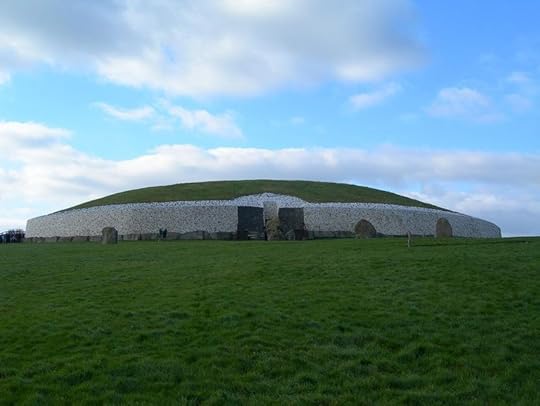
Older than both Stonehenge and the Egyptian pyramids, this impressive mound sits on a curve in the Boyne, a river still sacred to some in Ireland. The name Newgrange isn’t exactly new - it dates from the 1370s - however some still refer to the place by an older name, “Brú na Bóinne”, and this is the title given to the World Heritage Site that covers Newgrange and the complex of other megalithic tombs and stone circles in the area. The title “Brú na Bóinne” comes from medieval Irish tales written down three centuries earlier, but it’s sobering to think that that even then the place was four thousand years old and whatever the original name for the place was, or what its purpose was, has long been lost in the mists of time.
Some clues remain, however. Tantalizing hints that suggest meaning but could just be red herrings left by history to prompt us to jump to incorrect conclusions, or at least postualte theories that can never really be substantiated. In archeology the term “ritual site” seems to have become a common synonym for “we have no idea what went on here” and Newgrange fits into that category. Theories abound: Possibly a tomb, possibly a temple, maybe even a place were our ancestors took hallucinogenic drugs (the last one prompted by the unique spiraling rock art there). One thing is clear and that is that for some reason, the Winter Solstice was important to the people who built Newgrange.
On the shortest day of the year, the rising sun shines directly along the long passage into the central chamber at the heart of the mound. The sun enters the passage through a special opening, directly above the main entrance.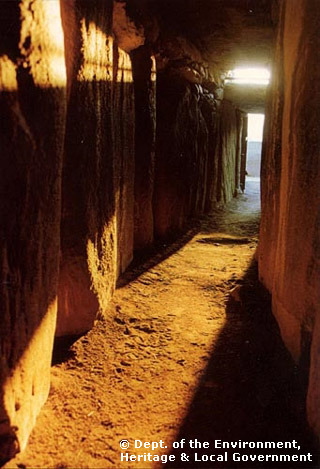
This can’t be a co-incidence, as another tomb nearby in Dowth also captures the sunlight on the soltice day. Clearly this event had enough significance to our distant ancestors to prompt them to take on such feats of engineering.
Its long been an ambition of mine to be there and witness this phenomenon in person. Mum and Dad took us to Newgrange in the late 1970s and we always talked about “some day” making the pre-dawn trip but somehow the solstice always came and went without us getting round to it. Unfortunately its fame and popularity is such now that the only chance to get in is by entering a lottery. You can enter it yourself if you feel lucky: http://www.newgrange.com/solstice-lot...
However, I’m excited to find that the event is streamed live on the internet: http://www.newgrange.com/webcast.htm, a sort of Soltice@Newgrange.com so maybe I will make it, at least virtually, after all.
Some people may baulk at the idea of modern technology invading even this most ancient of religious sites but to me it seems appropriate. The construction of Newgrange must have taken the most advanced technological capabilities available at the time: The calculations required to make sure the passage meets the sun on the Solstice alone are impressive and some folk at the time perhaps regarded it as sufficiently advanced to be somehow magic. It is a wonder of architecture, mathematics and engineering as sophisticated for it’s time as the Internet itself is to ours. Why shouldn’t the two come together?
I will finish with a piece of appropriate music. I thought maybe some sort of piece by Enya but in the end, what could be more appropriate for the Winter Solstice than a bit of Jethro Tull?
You can find the rest of the participants on the "Light in the darkness" blog hop here:Helen Hollick : A little light relief concerning those dark reviews! Plus a Giveaway Prize Debra Brown : The use of Light on Book Cover Art Prue Batten : Casting Light.... Alison Morton Shedding light on the Roman dusk Anna Belfrage Let there be light!Beth Elliott : Steering by the Stars: Stratford Canning in Constantinople, 1810 -12Melanie Spiller : Lux Aeterna, the chant of eternal light Janet Reedman The Winter Solstice MonumentsPetrea Burchard : Darkness - how did people of the past cope with the dark?Richard Denning : The Darkest Years of the Dark Ages: what do we really know? Plus a Giveaway Prize! Pauline Barclay Shedding Light on a Traditional PieDavid Ebsworth : Propaganda in the Spanish Civil WarDavid Pilling : Greek Fire
21st December is, of course, the shortest day of the year (for those in the northern hemisphere). John Dunne memorably described it as “the year’s midnight”. At this nadir of the calendar whatever life remains in the natural world seems to be withered and frozen to an almost dead stop. The wheel of time has slowed and rattled nearly to a complete stop. Dunne captured it brilliantly in his “Nocturnal upon St. Lucy’s Day”:
'… it is the day's, Lucy's, who scarce seven hours herself unmasks; The sun is spent, and now his flasks/Send forth light squibs, no constant rays; The world's whole sap is sunk;The general balm th' hydroptic earth hath drunk,Whither, as to the bed's feet, life is shrunk,
However, like all nadirs, this is a turning point. From here on the days begin to lengthen, the sun gets warmer and life begins to slowly but surely return to the world. As the theme of this blog hop goes, light will be shed in the darkness.
Clearly our ancestors felt this too, and nowhere is this more plain than in the megalithic monument in Ireland now called Newgrange.

Older than both Stonehenge and the Egyptian pyramids, this impressive mound sits on a curve in the Boyne, a river still sacred to some in Ireland. The name Newgrange isn’t exactly new - it dates from the 1370s - however some still refer to the place by an older name, “Brú na Bóinne”, and this is the title given to the World Heritage Site that covers Newgrange and the complex of other megalithic tombs and stone circles in the area. The title “Brú na Bóinne” comes from medieval Irish tales written down three centuries earlier, but it’s sobering to think that that even then the place was four thousand years old and whatever the original name for the place was, or what its purpose was, has long been lost in the mists of time.
Some clues remain, however. Tantalizing hints that suggest meaning but could just be red herrings left by history to prompt us to jump to incorrect conclusions, or at least postualte theories that can never really be substantiated. In archeology the term “ritual site” seems to have become a common synonym for “we have no idea what went on here” and Newgrange fits into that category. Theories abound: Possibly a tomb, possibly a temple, maybe even a place were our ancestors took hallucinogenic drugs (the last one prompted by the unique spiraling rock art there). One thing is clear and that is that for some reason, the Winter Solstice was important to the people who built Newgrange.
On the shortest day of the year, the rising sun shines directly along the long passage into the central chamber at the heart of the mound. The sun enters the passage through a special opening, directly above the main entrance.

This can’t be a co-incidence, as another tomb nearby in Dowth also captures the sunlight on the soltice day. Clearly this event had enough significance to our distant ancestors to prompt them to take on such feats of engineering.
Its long been an ambition of mine to be there and witness this phenomenon in person. Mum and Dad took us to Newgrange in the late 1970s and we always talked about “some day” making the pre-dawn trip but somehow the solstice always came and went without us getting round to it. Unfortunately its fame and popularity is such now that the only chance to get in is by entering a lottery. You can enter it yourself if you feel lucky: http://www.newgrange.com/solstice-lot...
However, I’m excited to find that the event is streamed live on the internet: http://www.newgrange.com/webcast.htm, a sort of Soltice@Newgrange.com so maybe I will make it, at least virtually, after all.
Some people may baulk at the idea of modern technology invading even this most ancient of religious sites but to me it seems appropriate. The construction of Newgrange must have taken the most advanced technological capabilities available at the time: The calculations required to make sure the passage meets the sun on the Solstice alone are impressive and some folk at the time perhaps regarded it as sufficiently advanced to be somehow magic. It is a wonder of architecture, mathematics and engineering as sophisticated for it’s time as the Internet itself is to ours. Why shouldn’t the two come together?
I will finish with a piece of appropriate music. I thought maybe some sort of piece by Enya but in the end, what could be more appropriate for the Winter Solstice than a bit of Jethro Tull?
You can find the rest of the participants on the "Light in the darkness" blog hop here:Helen Hollick : A little light relief concerning those dark reviews! Plus a Giveaway Prize Debra Brown : The use of Light on Book Cover Art Prue Batten : Casting Light.... Alison Morton Shedding light on the Roman dusk Anna Belfrage Let there be light!Beth Elliott : Steering by the Stars: Stratford Canning in Constantinople, 1810 -12Melanie Spiller : Lux Aeterna, the chant of eternal light Janet Reedman The Winter Solstice MonumentsPetrea Burchard : Darkness - how did people of the past cope with the dark?Richard Denning : The Darkest Years of the Dark Ages: what do we really know? Plus a Giveaway Prize! Pauline Barclay Shedding Light on a Traditional PieDavid Ebsworth : Propaganda in the Spanish Civil WarDavid Pilling : Greek Fire
Published on December 17, 2013 13:09
December 6, 2013
Historical Tales
I'm delighted and honoured to say that I have a short story in the latest anthology by the inkslingers (http://www.inkslingerbooks.co.uk/), "Historical Tales". This book is a collection of tales that span the centuries, it's now available in kindle format and includes stories by excellent writers like SJA Turney, Gordon Doherty, Prue Bratten, AJ Armitt, Paul Murphy, Jon Dickman, Rob Wickings and Robert Brooks.
 The stories:
The stories:
Fronto & Sybil - By SJA Turney - Set between Marius' Mules books 4 & 5: Fronto visits Rome's most famous oracle in the company of she-who-must-be-obeyed. Dreadful portents are fated to be revealed in the caves of Cumae.
The Gladiator - By Paul Murphy - It's judgement day for Danaus, the Empire's favorite gladiator, when he finds the past betrayal of his family, through a stolen love with a Senator's daughter, catching up with him on the sand of the arena floor.
The Pict - By Gordon Doherty - Urcal has known only the bitterness and brutality of war for so many years. But in his final hours he returns to the Wall where it all began, and comes face to face with his dark past.
Holmgang - By Tim Hodkinson - 941 AD. A small Irish Norse-Irish village cowers, expecting attack at any moment from a crew of ruthless vikings. A stranger arrives from the sea: Is he friend or foe?
Gisborne - By Prue Batten - The King’s man – as he nocks his arrow he wonders, is he a kingmaker or a kingbreaker?
The Conqueror - By AJ Armitt – As Mehmed the Conqueror’s army draws closer to the gates of Târgoviște; an encounter with a captured knight throws the likelihood of an easy conquest into doubt.
Onna Bugeisha - By SJA Turney - The widowed lady Shimoda Kumiko fights an impossible battle to defend her poor village from bandits, while a powerful ninja spins deadly webs among the powers of the province.
Thirteen - By Jon Dickman - In the aftermath of the Gunpowder Plot, two friends, condemned to death, are reunited and discover a higher treachery.
Trooper Jane - By SJA Turney - In the aftermath of the battle of Marston Moor, Oliver Cromwell pays a visit to the home of Sir William Ingilby in search of the Royalist officer who tried to put a bullet in his brain.
Conviction - By Prue Batten - Banished to ‘the arse end of the world’, a convict battles mind and body to stay alive and make sense of his punishment.
The Penitent - By Rob Wickings - Sister Carmen always believed that St. Ignatius was a refuge for women in a world where they were treated more than harshly-until Mary arrives to show her that forgiveness is just another form of sin.
Known unto God - By Jon Dickman - A deadly game of cat and mouse plays out beneath the blood soaked fields of Ypres. Lost in the deeper darkness, the hunters become the hunted.
Master Plan - By Robert Brooks – The Black Forest, Germany, and as the allies close in Hitler continues to plot while the Third Reich teeters towards its inevitable fall.
You can get the book here: http://www.amazon.co.uk/Historical-Ta...
 The stories:
The stories:Fronto & Sybil - By SJA Turney - Set between Marius' Mules books 4 & 5: Fronto visits Rome's most famous oracle in the company of she-who-must-be-obeyed. Dreadful portents are fated to be revealed in the caves of Cumae.
The Gladiator - By Paul Murphy - It's judgement day for Danaus, the Empire's favorite gladiator, when he finds the past betrayal of his family, through a stolen love with a Senator's daughter, catching up with him on the sand of the arena floor.
The Pict - By Gordon Doherty - Urcal has known only the bitterness and brutality of war for so many years. But in his final hours he returns to the Wall where it all began, and comes face to face with his dark past.
Holmgang - By Tim Hodkinson - 941 AD. A small Irish Norse-Irish village cowers, expecting attack at any moment from a crew of ruthless vikings. A stranger arrives from the sea: Is he friend or foe?
Gisborne - By Prue Batten - The King’s man – as he nocks his arrow he wonders, is he a kingmaker or a kingbreaker?
The Conqueror - By AJ Armitt – As Mehmed the Conqueror’s army draws closer to the gates of Târgoviște; an encounter with a captured knight throws the likelihood of an easy conquest into doubt.
Onna Bugeisha - By SJA Turney - The widowed lady Shimoda Kumiko fights an impossible battle to defend her poor village from bandits, while a powerful ninja spins deadly webs among the powers of the province.
Thirteen - By Jon Dickman - In the aftermath of the Gunpowder Plot, two friends, condemned to death, are reunited and discover a higher treachery.
Trooper Jane - By SJA Turney - In the aftermath of the battle of Marston Moor, Oliver Cromwell pays a visit to the home of Sir William Ingilby in search of the Royalist officer who tried to put a bullet in his brain.
Conviction - By Prue Batten - Banished to ‘the arse end of the world’, a convict battles mind and body to stay alive and make sense of his punishment.
The Penitent - By Rob Wickings - Sister Carmen always believed that St. Ignatius was a refuge for women in a world where they were treated more than harshly-until Mary arrives to show her that forgiveness is just another form of sin.
Known unto God - By Jon Dickman - A deadly game of cat and mouse plays out beneath the blood soaked fields of Ypres. Lost in the deeper darkness, the hunters become the hunted.
Master Plan - By Robert Brooks – The Black Forest, Germany, and as the allies close in Hitler continues to plot while the Third Reich teeters towards its inevitable fall.
You can get the book here: http://www.amazon.co.uk/Historical-Ta...
Published on December 06, 2013 05:46
August 14, 2013
The Wonder of Rome
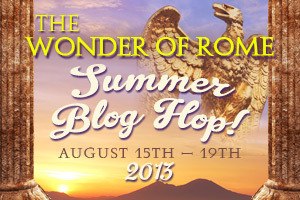
This post is part of a blog hop (the first one I’ve ever done), the theme of which is “The Wonder of Rome”. At the bottom of the post you can link to, hop over and read more of what other historical fiction writers interpretation of this theme is. Perhaps predictably, mine relates to war.
There is no doubt that ancient Rome still holds a fascination for us today. The achievement of its Empire and the civilization it created are undeniable, the fact that it’s language-Latin-is still a lingua franca in medicine and science by itself validates the theme of this blog, and there are a myriad of other possible topics that could be described as wonders that still hold the attention and amazement of modern people today. For anyone looking for a quick summary, you can watch this:
However, setting central heating, roads etc. aside, I think I can name one Roman related object that casts a very long shadow that reaches from the 1st century AD through to the vikings and down to the middle ages. By happy co-incidence that would also manage to provide a connection my new book “Spear of Crom”-set in Roman Britain-with my medieval book, “Lions of the Grail”.
For my “Wonder of Rome”, I’ve chosen the spatha, the long, broad-bladed sword first used by auxiliary cavalry units in the Roman army.
When we picture the Roman soldier, the image that usually springs to mind is one of the legionary with his rectangular shield and short sword, the gladius. However in terms of longevity and influence (on swords at least) it was the spatha that cast the longest shadow. The spatha was about a meter long, making it about a foot longer than the stabbing gladius. The sides of its 4 to 6 cm wide blade were straight and for most of its length almost parallel, then tapered at the end to either a sharp or rounded point, depending on whether it was the infantry or cavalry version.
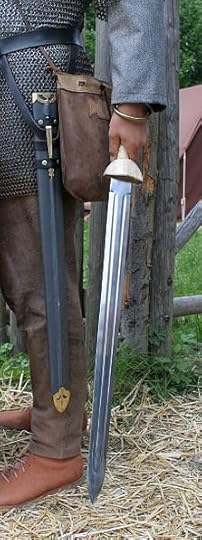
For the cavalry, the tip of the blade was rounded to prevent a trooper stabbing himself in the foot or accidentally injuring his mount. The purpose of the the weapon was for slashing downward at the enemy from horseback and the blade’s extra length helped with that. The infantry version, which seems to have appeared in service during the 3rd Century AD, had a sharp tip that allowed infantry in the front ranks of battle a longer reach. The name appears to have come from ancient Greek however the weapon itself seems to have come from either the Celts or the Germans. As auxiliary troops from those nations joined the Roman army they seem to have brought their own distinctive sword pattern with them, and this migration began with fighting units that were aligned to the particular talents of those nations. Our modern word “ally” (perhaps most famous nowadays from the Word War 2 Coalition of Allies) derives directly from the name of the cavalry regiments who accompanied the legions: the Allae. The word translates as “wing” rather than “friendly nation” but that is due to the placement of these units on the battlefield, where they spread out like the wings of the eagle on either side of the legionary foot soldiers to guard their flanks from attack. The Roman legionaries all had one one thing in common. Every last one of them, from the son of the rich Roman who joined up for adventure, to the merchant who joined the army to escape his debts, to the man who enlisted because he thought it was an honorable career and even right down to the scumbag who had been dragged out of prison and pressed into military service, all of them were Roman citizens. The cavalry came from allied (aka conquered) nations of Rome. They were not citizens, however, through military service (usually 25 years of it) they could earn their diploma, and with it the right to become citizens of Rome. The cavalry around the 1st century were celts and Germans from the newly conquered Gaul and Germania territories and it seems these warriors brought not just their superb horsemanship to the Roman Army but also their characteristic long bladed swords. The First Century Roman historian Tacitus first mentions these swords in his account of how the British King Catactacus during a battle in his insurgency against Rome found himself between a rock and a hard place: with the legionaries and their gladii on one side and the auxiliaries and their spathae on the other. A couple of centuries later and the legionaries themselves were carrying the spatha instead of the gladius. This may have been because of the phasing out of the large rectangular shield and the increased need to put some extra distance between the Roman soldier and his enemy. After becoming the standard sword of the Roman army the spatha design of sword continued to be produced across Northern Europe (or perhaps the design was perpetuated where it had originally emerged from?). It gave birth to the classic ring sword of the Migration Period (most probably the weapon Beowulf wielded against Grendal’s Mother). As Bram Stoker memorably put it in Dracula, when the vikings “bore down from Iceland the fighting spirit which Thor and Wodin gave them, which their Berserkers displayed to such fell intent on the seaboards of Europe, aye, and of Asia and Africa too, till the peoples thought that the werewolves themselves had come”, they bore with them swords still recognizable as the spatha pattern. The viking sword is regarded as the last recognizable descendant of the spatha, though the half-civilized offspring of French-settled vikings, the Normans, carried “arming swords” across the English channel in 1066 and these weapons represented the final transition of the spatha from viking weapon to what would become the representative weapon of the medieval knight. Indeed, without his sword a knight could not even be a knight, as it was crucial to his vows and the rituals around the making of a knight.
So as this journey ends I urge you to continue to explore the Wonders of Rome by visiting the other authors who are participating in this blog hop. You can "hop" to their own takes on this theme at the links below:
David Blixt
S.J.A. Turney
Gordon Doherty
Manda Scott
Petrea Burchard
Heather Domin
Ruth Downie
Helen Hollick
Scott Hunter
Alison Morton
Fred Nath
Mark Patton
Elisabeth Storrs
Brian Young
Published on August 14, 2013 17:33
August 2, 2013
Review of the Spear of Crom
Great, and much appreciated, review of Spear of Crom on Historical Fiction Reviews!
http://hooverbookreviews.wordpress.com/2013/08/01/the-spear-of-crom-by-tim-hodkinson/
http://hooverbookreviews.wordpress.com/2013/08/01/the-spear-of-crom-by-tim-hodkinson/
Published on August 02, 2013 08:20
July 25, 2013
Lughnasa
The time of year of the ancient pagan Celtic festival of Lughnasa is approaching. Adherents in the reconstructed pagan religions like wicca and druidry will point out that this festival is also part of the modern pagan calendar too, and on reflection in many ways it has never really gone away.About ten years ago, on the last Sunday in July, my wife and I climbed Slieve Croob, a small mountain in County Down, Northern Ireland and the source of the river Lagan (the main river that eventually flows to the sea through Belfast).
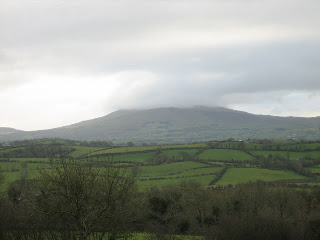
We had not been going out for long at the time and were still desperately trying to appear as sporty and outdoor-type to each other as possible, so we went through a phase of mountain climbing, biking, snowboarding and the like so as to appear ”wind swept and interesting” as Billy Connolly put it. It was a typical July day in Northern Ireland: Overcast, misty with the odd shower of rain and we were out for a Sunday afternoon walk. As we climbed the hill we were surprised by the number of other people who emerged from the gray mist above us on their way back down the mountain. Unlike us with our hiking boots and peter storm jackets they wore everyday clothes form jeans to tracksuits to trainers and duffle coats. There were a lot of young children and quite a few old people too. These were clearly ordinary people rather than hill walker types. In the car park at the bottom of the hill they were catered for by a table full of orange squash and an ice cream van.
What we didn’t know then but I do know now, was that these people were taking part in a ritual that goes back to time immemorial. For millennia, people in Ireland have been climbing up mountains around the end of July or the start of August as part of the rituals around the festival of Lughnasa. The folklorist Máire MacNeill published a study of the festival in her book “The Festival of Lughnasa”. Through comprehensive study of medieval and surviving traditions she pieced together a picture of a festival that involved the common elements of the faithful climbing mountains to honour their Gods, the sacrifice of a bull and some sort of ritual play where a young God is imprisoned by an Old God, but eventually escapes and triumphs, a story that may still survive in the mummers plays today.
Who were those Gods? The name of one of them is obvious and appears in the name of the festival. Lugh was the long-armed, many talented God who was worshipped in one form or another across Celtic Europe and after who towns as diverse as Lyon in France, Leiden in Holland and Loudoun in Scotland are named. He was the father of Ireland’s most famous hero, Cuchulain and his deeds are the subject of many ancient Irish tales and medieval Irish Literature. He currently is having a renaissance within the Wiccan and other neo-pagan religions that blossom across the Internet.
Who Lugh’s dark opponent was is more obscure. One of the other names for this time of year, however, was Domhnach Chrom Dubh - Black Crom’s Sunday. While Lugh’s memory may survive, if anyone has heard of Crom these days, the chances are it is as the God worshiped by Conan the Barbarian, either in Robert E Howard’s sword and sandal epics, or in the 1980s movie starring Arnold Schwarzenegger. After all, who could forget such classic cinematic moments this ?
Alternatively, it may be familiar as the name of the castle in County Fermanagh currently being used as a location for the new BBC series “Blandings” based on P. G. Wodehouse’s books .
Few will be aware that Crom was a God worshiped by the ancient Irish. And not just any old God either. It looks like Crom could well have been the main deity worshiped by the original people of Ireland and the tale of Lugh’s battle with him could well be a mythologized version of the battle between the incoming Celts with their new Gods and the indigenous people. His religion is associated with a bull, standing stones (an ancient name for a ring of standing stones was a cromlech) and, as readers of my novel “The Spear of Crom” will know, human sacrifice. He survived into the Christian era too. When Christianity came to Ireland, the Church had the extremely successful idea of taking over existing traditions and holy places instead of stopping or destroying them. The Goddess Bridget merged with Saint Bridget. Saint Patrick replaced Lugh as the spiritual hero of the people and it is he who we see going head to head with Crom (and defeating him) in the surviving tales. Another tradition the Church took over was the tradition of climbing hills at Lughnasa. The pagan pilgrimage became known as Garland Sunday, or Blaeberry Sunday. The actions were the same but now its Jesus and the Christian Saints who are honored.
And that's what those people were doing that misty Sunday on Slieve Croob. Did they know they were continuing a tradition going back to pagan times? I don’t know but I’ve always thought the nearby village of Dromara has more that a touch of “The Wicker Man” about it.
I’ve chosen the last Sunday in July (this Sunday) as the most appropriate date for the end of the Goodreads Giveaway competition to win a copy of “The Spear of Crom”. You can enter here: http://www.goodreads.com/giveaway/show/57666-the-spear-of-crom

We had not been going out for long at the time and were still desperately trying to appear as sporty and outdoor-type to each other as possible, so we went through a phase of mountain climbing, biking, snowboarding and the like so as to appear ”wind swept and interesting” as Billy Connolly put it. It was a typical July day in Northern Ireland: Overcast, misty with the odd shower of rain and we were out for a Sunday afternoon walk. As we climbed the hill we were surprised by the number of other people who emerged from the gray mist above us on their way back down the mountain. Unlike us with our hiking boots and peter storm jackets they wore everyday clothes form jeans to tracksuits to trainers and duffle coats. There were a lot of young children and quite a few old people too. These were clearly ordinary people rather than hill walker types. In the car park at the bottom of the hill they were catered for by a table full of orange squash and an ice cream van.
What we didn’t know then but I do know now, was that these people were taking part in a ritual that goes back to time immemorial. For millennia, people in Ireland have been climbing up mountains around the end of July or the start of August as part of the rituals around the festival of Lughnasa. The folklorist Máire MacNeill published a study of the festival in her book “The Festival of Lughnasa”. Through comprehensive study of medieval and surviving traditions she pieced together a picture of a festival that involved the common elements of the faithful climbing mountains to honour their Gods, the sacrifice of a bull and some sort of ritual play where a young God is imprisoned by an Old God, but eventually escapes and triumphs, a story that may still survive in the mummers plays today.
Who were those Gods? The name of one of them is obvious and appears in the name of the festival. Lugh was the long-armed, many talented God who was worshipped in one form or another across Celtic Europe and after who towns as diverse as Lyon in France, Leiden in Holland and Loudoun in Scotland are named. He was the father of Ireland’s most famous hero, Cuchulain and his deeds are the subject of many ancient Irish tales and medieval Irish Literature. He currently is having a renaissance within the Wiccan and other neo-pagan religions that blossom across the Internet.
Who Lugh’s dark opponent was is more obscure. One of the other names for this time of year, however, was Domhnach Chrom Dubh - Black Crom’s Sunday. While Lugh’s memory may survive, if anyone has heard of Crom these days, the chances are it is as the God worshiped by Conan the Barbarian, either in Robert E Howard’s sword and sandal epics, or in the 1980s movie starring Arnold Schwarzenegger. After all, who could forget such classic cinematic moments this ?
Alternatively, it may be familiar as the name of the castle in County Fermanagh currently being used as a location for the new BBC series “Blandings” based on P. G. Wodehouse’s books .
Few will be aware that Crom was a God worshiped by the ancient Irish. And not just any old God either. It looks like Crom could well have been the main deity worshiped by the original people of Ireland and the tale of Lugh’s battle with him could well be a mythologized version of the battle between the incoming Celts with their new Gods and the indigenous people. His religion is associated with a bull, standing stones (an ancient name for a ring of standing stones was a cromlech) and, as readers of my novel “The Spear of Crom” will know, human sacrifice. He survived into the Christian era too. When Christianity came to Ireland, the Church had the extremely successful idea of taking over existing traditions and holy places instead of stopping or destroying them. The Goddess Bridget merged with Saint Bridget. Saint Patrick replaced Lugh as the spiritual hero of the people and it is he who we see going head to head with Crom (and defeating him) in the surviving tales. Another tradition the Church took over was the tradition of climbing hills at Lughnasa. The pagan pilgrimage became known as Garland Sunday, or Blaeberry Sunday. The actions were the same but now its Jesus and the Christian Saints who are honored.
And that's what those people were doing that misty Sunday on Slieve Croob. Did they know they were continuing a tradition going back to pagan times? I don’t know but I’ve always thought the nearby village of Dromara has more that a touch of “The Wicker Man” about it.
I’ve chosen the last Sunday in July (this Sunday) as the most appropriate date for the end of the Goodreads Giveaway competition to win a copy of “The Spear of Crom”. You can enter here: http://www.goodreads.com/giveaway/show/57666-the-spear-of-crom
Published on July 25, 2013 18:12
July 1, 2013
Goodreads Giveaway: The Spear of Crom
My new book, The Spear of Crom is currently running as a Goodreads giveaway from now until the old pagan holiday of Crom Cruach, Black Crom's Sunday. For your chance to win one of 2 free copies of the novel, go to http://www.goodreads.com/giveaway/show/57666-the-spear-of-crom
Published on July 01, 2013 12:10
May 24, 2013
Bernard Cornwell
Last night I made the trip down to Cape Cod to see Bernard Cornwell speak at the Osterville library. I was slightly surprized by the venue. Osterville has the look to me of my village of Moira back home: The sort of one-street hamlet where upper middle class ladies go on a Saturday afternoon to get their hair done, look at expensive clothes and then have a cup of coffee and a bun. The library is an impressive, new building but it is still not exactly the venue you would expect to see a best-selling author with the reputation of Cornwell in. The room was understandably packed though there must have been no more than forty or fifty people there. It is rare enough to get the chance to listen in person to a man who could well be described as the master of modern Historical Fiction, but to listen to him speaking in a small room to such a small group of people was unique. In the UK Bernard Cornwell could easily fill a space the size of the whole library and draw a crowd ten or twenty times that size, so it was a great opportunity to listen and ask questions. Not only that but there were juice and cookies supplied!
Cornwell was a tremendously entertaining speaker, talking for over an hour and a half, completely off the cuff, fielding questions and keeping his audience enthralled and amused throughout. The official theme of the talk was supposed to be Cornwell’s book 1356 (or “four minutes to two” as he repeatedly referred to it, much to the bemusement of the American audience). The book has just been launched in the USA, however he ranged over a wide range of topics from how he first got published to fascinating insights into his writing process. Someone with the writing track record of Bernard Cornwell has every right to blow their own trumpet, but despite his declarations of self-promotion, I found him in many ways quite modest and self-deprecating. Through snippets and stories about his life and career glimpses of the sheer depth of the man’s historical knowledge became clear, as well as the lengths to which he is prepared to go in the name of research. At one point he waded into an Indian river to judge its depth and see whether Sharpe and his men would have had to hold their equipment over their heads. The fact that no one beyond the residents of the nearby village would actually know how deep that river is says a lot about his commitment to veracity.For someone like me who has been a long term fan of Cornwell the evening was a veritable cornucopia of information, like how Richard Sharpe got his name (after an English rugby player), why there is a rifleman Dodd in Sharpe’s squad or why he really stopped writing the Starbuck stories, along with hints and tips about how he got where he is today. Some things he said that particularly stick in my mind are: It’s not that hard to write something. It’s harder to write well. It’s very difficult to write something that people are interested in reading. Also, there is no such thing as writer’s block. Can you imagine a nurse phoning into Cape Cod hospital and saying I can’t come to work today because I’ve got nurse’s block? At the time, it came as surprise to me that Cornwell is one of those writers how doesn’t plan his stories. He just sits down and writes them. However on reflection, having witnessed the man in action, it is obvious he was born with a genius for story-telling, whether it be about walking his dog passed a civil war commemoration in Charlestown or a series of books about Dark Age Britain, there is no question that Bernard Cornwell keeps his respective audience thoroughly entertained (and-dare I say-a little bit educated too).Exciting news came in the form of his upcoming works: A non-fiction book about Waterloo then a whole new series kicking off next year. After it was over he did not simply rush away but made time to speak to everyone, sign books and briefly chat, no matter how inane the questions or comments were from awkward, slightly tongue tied fans (like myself). At one point in his talk, Cornwell touched on the current crisis in the publishing industry and likened it to what has already happened in the music industry. “Musicians can still get by though as they can tour,” he said. “But no one is going to pay $150 to listen to listen to me talking.”After last night’s performance, I for one wouldn’t be too sure.The event was organised by Books by the Sea , the excellent independent bookshop in Osterville, and I would like to thank both them for going to the effort and Bernard Cornwell for providing such an entertaining and enlightening evening.
Published on May 24, 2013 18:01
May 14, 2013
New Book: The Spear of Crom
I'm delighted to say that my new book, The Spear of Crom, is now available in paperback.
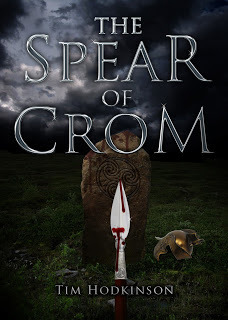
This is the "blurb" from the back cover:
"68 AD. The XIV Legion under the command of General Suetonius and the Tribune, Gnaeus Julius
Agricola, march west on a mission to crush insurgent tribes in Rome's newest Province, Britannia.
Fergus MacAmergin is an officer in a Celtic auxiliary cavalry regiment riding alongside the Legion.
As the British tribes wage guerrilla war on the Romans, Fergus falls foul of his commander. His
punishment is to lead a squad of men on a suicidal mission deep behind enemy lines.
Joining forces with Agricola, Fergus is tasked with finding a mystical spear, said to be the weapon
that pierced the side of Jesus Christ on the cross.
As the assignment unfolds, it becomes clear that there is more to the spear than meets the eye and
he is heading directly for a confrontation with dark forces from his past."
The paperback is available here (http://www.feedaread.com/books/The-Spear-of-Crom-9781782993476.aspx) and on Amazon in a couple of weeks from now. Also in Kindle
format (http://www.amazon.com/The-Spear-of-Crom-ebook/dp/B00BFHIP7M).
Published on May 14, 2013 18:34
May 1, 2013
New Website!
After some comments that apparently my digital footprint is rather small, I've finally got round to getting myself a website for my books, writing, upcoming news and as a way for folks to contact me. Hopefully it will take off and become the hub for my online life but this represents the first step. I'm pleased with how it looks and so far the feedback has been good. Step one was establishing it. Step 2 will be incorporating this blog into it and working out a way to syndicate it.So please take some time to check it out: http://www.timhodkinson.com/
For those of you interested in the technicalities of how it was built, all I can say is HTML5 rocks
For those of you interested in the technicalities of how it was built, all I can say is HTML5 rocks

Published on May 01, 2013 08:56
March 5, 2013
On Scythed Chariots
I mentioned on an internet forum that my new book “The Spear of Crom” had “Romans, Celts and scythed chariots” and another member asked the question “isn't there quite a bit of doubt about the use of scythed chariots in Britain?”
That is a very good question. Speak of scythed chariots and the image of the statue of Boadicea in London probably springs to mind. It’s impressive but is it historically accurate?
The use of war chariots by British tribes is recorded by classical writers, e.g. Tacitus mentions them being used by the Caledonions against the Romans at the battle of Mon Graupius (which happened somewhere in Scotland round about 83 AD). Whether these bore scythes or not is a different matter. There is one specific classical reference to scythed chariots in Britain but I believe current academic opinion is that this was just Roman propaganda. There also seems to be a lack of archaeological evidence, but then there is no archaeological evidence for the druids (who also play a key role in my book), either.
My rather brief description on the forum, however, was inaccurate on 2 counts: What appears in my book is not hordes of "scythed chariots" but an instance of a war machine called a "sickle chariot". The hero of my book is a Hibernian based very loosely on an ancient Irish hero called Conal Cernach combined with another character from Irish history who may or may not have hung around with Gnaeus Julius Agricola in the 1st Century AD. As mentioned in my last post about the druids, in writing the book I used a lot of research from early Irish literature, particularly the Táin Bó Cúailnge, the Táin Bó Fraích and the Táin Bó Flidhais. While the existing texts of these works are very early medieval the language used is much older and the setting is traditionally around the time of Christ, so bang on for the period my book is set.
I took my rather outlandish depictions of the druids (e.g. wearing cloaks made of bird feathers or bull hide) from these sources rather than the modern new age idea that seems to be based on 19th century revivalism. It was in Thomas Kinsella's translation of the Táin Bó Cúailnge that I found a description of a rather impressive device used by the hero Cú Chulainn called the sickle (as opposed to scythed) chariot. That vehicle is described as being covered all over with spikes and sharp points, rather than revolving blades on the axles, and the "sickle" name seems to come from the power it gives Cú Chulainn to mow down his enemies.
Probably like those ancient Roman propagandists, I loved the idea of ancient Celts in scythed chariots. However the actual effectiveness of those revolving blades on the axles of the chariot always bothered me. Then shortly after arriving here in the USA I saw a show on the Discovery Channel where they tried to re-create a scythed chariot based on designs created by Leonardo da Vinci in the 15th Century. It worked, but the key difference was that the blades rotate horizontally to the ground, like helicopter blades, not vertically (as in if they stick straight out from the main axles). It struck me that scythe blades swooping round this way much more align to the idea of a "sickle chariot" that reaps a bloody harvest than the conventional idea.
Anfad, the villain in the book, is a druid with connections to Ireland (he studied druidry there) and wanted to give him something that made him an even more formidable opponent for Fergus the hero. The idea occurred to me that a sickle chariot inspired by a combination of early medieval Irish literature and Leonardo da Vinci’s designs would be tremendously cool :-) Yes, I know that probably makes him more of a Bond villain but that maybe gives you an idea of what the book is like. Heck, there is also a magic spear in it- though hopefully the book explains just enough of the science behind it to make it plausible.
The idea of the chariot also led to tremendously gory final battle which was an absolute joy to write (and hopefully read).
Published on March 05, 2013 08:06



